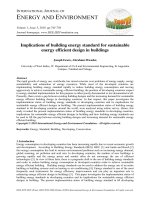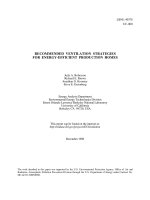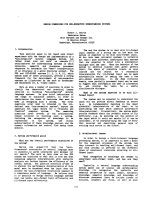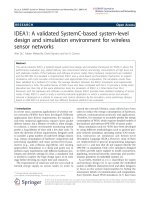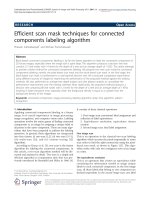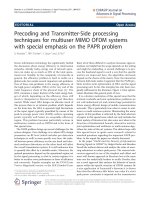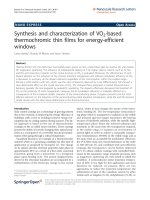System level design techniques for energy efficient embedded systems
Bạn đang xem bản rút gọn của tài liệu. Xem và tải ngay bản đầy đủ của tài liệu tại đây (13.55 MB, 213 trang )
SYSTEM-LEVEL DESIGN TECHNIQUES FOR ENERGY-EFFICIENT
EMBEDDED SYSTEMS
This page intentionally left blank
System-Level Design
Techniques for Energy-Efficient
Embedded Systems
by
MARCUS T. SCHMITZ
University of Southampton, United Kingdom
BASHIR M. AL-HASHIMI
University of Southampton, United Kingdom
and
PETRU ELES
Linköping University, Sweden
KLUWER ACADEMIC PUBLISHERS
NEW YORK, BOSTON, DORDRECHT, LONDON, MOSCOW
eBook ISBN:
Print ISBN:
0-306-48736-5
1-4020-7750-5
©2005 Springer Science + Business Media, Inc.
Print ©2004 Kluwer Academic Publishers
Dordrecht
All rights reserved
No part of this eBook may be reproduced or transmitted in any form or by any means, electronic,
mechanical, recording, or otherwise, without written consent from the Publisher
Created in the United States of America
Visit Springer's eBookstore at:
and the Springer Global Website Online at:
To our beloved families
This page intentionally left blank
Contents
List of Figures
List of Tables
Preface
Acknowledgments
ix
xiii
xv
xvii
1. INTRODUCTION
1.1 Embedded System Design Flow
1.2 System Specification
1.3 Co-Synthesis
1.4 Hardware and Software Synthesis
1.5 Book Overview
1
2
5
6
14
17
2. BACKGROUND
2.1 Energy Dissipation of Processing Elements
2.2 Energy Minimisation Techniques
2.3 Energy Dissipation of Communication Links
2.4 Further Readings
2.5 Concluding Remarks
19
3. POWER VARIATION-DRIVEN DYNAMIC VOLTAGE SCALING
3.1 Motivation
3.2 Algorithms for Dynamic Voltage Scaling
3.3 Experimental Results: Energy-Gradient based Dynamic Voltage
Scaling
3.4 Concluding Remarks
4. OPTIMISATION OF MAPPING AND SCHEDULING FOR
DYNAMIC VOLTAGE SCALING
vii
19
24
29
30
33
35
36
44
50
58
61
viii
SYSTEM-LEVEL DESIGN TECHNIQUES
Schedule Optimisation
Optimisation of Task and Communication Mapping
Optimisation of Allocation
Concluding Remarks
62
81
94
97
5. ENERGY-EFFICIENT MULTI-MODE EMBEDDED SYSTEMS
5.1 Preliminaries
5.2 Motivational Examples
5.3 Previous Work
5.4 Problem Formulation
5.5 Co-Synthesis of Energy-Efficient Multi-Mode Systems
5.6 Experimental Results: Multi-Mode
5.7 Concluding Remarks
99
100
104
107
109
111
122
130
4.1
4.2
4.3
4.4
6. DYNAMIC VOLTAGE SCALING FOR CONTROL FLOWINTENSIVE APPLICATIONS
by Dong Wu, Bashir M. Al-Hashimi, and Petru Eles
6.1 The Conditional Task Graph Model
6.2 Schedule Table for CTGs
6.3 Dynamic Voltage Scaling for CTGs
6.4 Voltage Scaling Technique for CTGs
6.5 Conclusions
133
135
136
139
148
7. LOPOCOS: A LOW POWER CO-SYNTHESIS TOOL
7.1 Smart Phone Description
7.2 LOPOCOS
7.3 Concluding Remarks
151
151
157
172
8. CONCLUSION
8.1 Summary
8.2 Future Directions
173
174
177
133
References
181
Index
193
List of Figures
1.1
Example of a typical embedded system (smart-phone)
2
1.2
Typical design flow of a new embedded computing system
4
1.3
MP3 decoder given as (a) task graph specification (17
tasks and 18 communications) and (b) high-level language description in C
System-level co-synthesis flow
7
8
1.4
1.5
1.6
1.7
1.8
1.9
1.10
1.11
2.1
2.2
2.3
2.4
2.5
2.6
2.7
3.1
Architectural selection problem
9
Application mapping onto hardware and software components 10
Two different scheduling variants based on the same
allocated architecture and identical application mapping
12
System schedule with idle and slack times
13
The concept of dynamic voltage scaling
Hardware synthesis flow
Software synthesis flow
14
15
16
Dynamic power dissipation of an inverter circuit [37]
Supply voltage dependent circuit delay
20
22
Energy versus delay function using fixed and dynamic
supply voltages (considering
and
Block diagram of DVS-enabled processor [36]
24
25
Shutdown during idle times (DPM)
Voltage scaling to exploit the slack time (DVS)
Combination of dynamic voltage scaling and dynamic
power management
Architecture and specification for the motivational example
ix
27
28
28
37
x
SYSTEM-LEVEL DESIGN TECHNIQUES
3.2
3.3
3.4
3.5
3.6
3.7
3.8
3.9
3.10
4.1
4.2
4.3
4.4
4.5
4.6
4.7
4.8
4.9
4.10
4.11
4.12
4.13
4.14
4.15
Power profile of a possible mapping and schedule at
nominal supply voltage (no DVS is applied)
Two different voltage scaled schedules
Pseudo code of the proposed heuristic (PV-DVS) algorithm
Capturing the mapping and schedule information into
the task graph by using pseudo edges and communication task
Pseudo code of task graph to mapped-and-scheduled
task graph transformation
Three identical execution orders of the tgff17_m benchmark: (a) unscaled execution at nominal supply voltage
(NO-DVS), (b) using the EVEN-DVS, and (c) the PVDVS approach
Energy reduction quality dependent on minimal extension time
Execution time dependent on minimal extension time
Energy reduction quality dependent on execution time
Co-synthesis flow for the optimisation of scheduling
and mapping towards the utilisation of PV-DVS
Specification and DVS-enabled architecture
A possible schedule not optimised for DVS
Schedule optimised for DVS considering the power variation model
List scheduling
Task priority encoding into a priority string
Principle behind the genetic list scheduling algorithm
Proposed EE-GLSA approach for energy-efficient schedules
Hole filling problem
Task mapping string describing the mapping of five
tasks to an architecture
Proposed EE-GTMA approach for energy-efficient task
mappings
Combined optimisation of task and communication mapping
A combined priority and communication mapping string
Proposed EE-GLSCMA approach for combined optimisation of energy-efficient schedules and communication mappings
Three scheduling and mapping concepts
39
41
45
46
47
54
56
56
57
62
63
64
65
70
70
71
73
74
82
83
85
86
88
90
List of Figures
4.16
5.1
5.2
5.3
5.4
5.5
5.6
5.7
5.8
5.9
5.10
5.11
5.12
5.13
5.14
5.15
6.1
6.2
6.3
6.4
6.5
6.6
6.7
6.8
7.1
7.2
7.3
Nine different implementation possibilities of the OFD
algorithm
Example operational mode state machine of a smart phone
Relation between OMSM and individual task graph specifications
Distributed Architectural Model
Mode execution probabilities
Multiple task type implementations
Typical Activation Profile of a Mobile Phone
Task mapping string for multi-mode systems
Pseudo Code: Multi-Mode Co-Synthesis
Pseudo Code: Mapping Modification towards component shutdown
DVS Transformation for HW Cores
DVS Transformation for HW Cores considering interPE communication
Pseudo code: Task graph transformation for DVS-enabled
hardware cores
Pareto optimal solution space achieved through a single
optimisation run of mul15 (without DVS), revealing the
solution trade-offs between energy dissipation and area usage
A system specification consisting of two operational
modes optimized for three different execution probabilities (solid line–0.1:0.9, dashed–0.9:0.1, dotted–0.5:0.5)
Energy dissipation of the Smart phone using different
optimisation strategies
Conditional Task Graph and its Tracks
Schedules of the CTG of Figure 6.1 (a) (in this figure
corresponds to tasks
Schedules scaled for energy minimisation
Improper scaling with violated timing constraint
CTG with one disjunction node
Schedules
Pseudo-code: Voltage scaling approach for CTGs
Actual, scaled schedules
Block diagram of the GSM RPE-LTP transcoder [73]
Task graph of the GSM voice encoder
Task graph of the GSM voice decoder
xi
97
101
102
103
105
107
112
113
114
117
119
120
121
125
127
130
134
137
138
138
140
141
142
145
152
154
155
xii
SYSTEM-LEVEL DESIGN TECHNIQUES
7.4
7.5
7.6
7.7
7.8
7.9
7.10
7.11
7.12
7.13
7.14
8.1
Block diagram of the MPEG-1 layer 3 audio decoder
Block diagram of the JPEG encoder and decoder [149]
Task graphs of the JPEG encoder and decoder
Design flow used within LOPOCOS
File description of the top-level finite state of the smart phone
File description of a single mode task graph
Technology library file
Co-synthesis results of Architecture 1
Co-synthesis results of Architectures 2 and 3
Co-synthesis results for Architectures 2 and 3, exploiting DVS
Co-synthesis results for Architecture 4
Network-on-Chip
156
156
157
159
160
162
163
168
169
170
171
179
List of Tables
1.1
1.2
3.1
3.2
3.3
3.4
3.5
4.1
4.2
4.3
4.4
4.5
Trade-offs between serveral heterogeneous components
(+ + highly advantageous, +
advantageous, o
moderate, - disadvantageous, - - highly disadvantageous)
Task execution properties (time and power) on different
processing elements
Nominal task execution times and power dissipations
Communication times and power dissipations of communication activities mapped to the bus
Evolution of the energy-gradients during voltage scaling
Comparison of the presented PV-DVS optimisation with
the fixed power model using EVEN-DVS approach
PV-DVS results using the benchmarks of Bambha et al. [20]
Nominal execution times and power dissipations for the
mapped tasks
Experimental results obtained using the fixed power
model and the power variation model during voltage
selection; both integrated into a genetic list scheduling
algorithm
Experimental results obtained using the generalised,
DVS optimised scheduling approach for benchmark example TG1
Experimental results obtained using the generalised,
DVS optimised scheduling approach for benchmark example TG2
Mapping optimisation with and without DVS optimised
scheduling using tgff and hou benchmarks
xiii
9
10
38
38
42
52
53
63
77
79
80
90
xiv
SYSTEM-LEVEL DESIGN TECHNIQUES
4.6 Mapping optimisation of the benchmark set TG1 using
NO-DVS (Nominal), EVEN-DVS, and PV-DVS
Comparison between DLS algorithm and the proposed
4.7
scheduling and mapping approach using Bambha’s benchmarks [20]
Increasing architectural parallelism to allow voltage scal4.8
ing of the OFD algorithm
Relaxing the performance constraints of the OFD algorithm
4.9
Task execution and implementation properties
5.1
Considering mode execution probabilities (excluding DVS)
5.2
Considering mode execution probabilities (including DVS)
5.3
Smart phone experiments without DVS
5.4
Smart phone experiments with DVS
5.5
6.1
Example Schedule Table for the CTG of Figure 6.1(a)
6.2
Schedule Table for the CTG of Figure 6.5
Scaled Schedule Table for the CTG of Figure 6.5
6.3
Pre-processed schedule table
6.4
Result
after processing column true (values are rounded)
6.5
Results after processing column A
6.6
Final schedule table (scaled)
6.7
Results of the real-life example
6.8
Results of the generated examples
6.9
6.10
Results of the mapping optimisation
Task independent components parameters
7.1
Task dependent parameters
7.2
Components in a typical technology library
7.3
92
93
96
96
105
123
125
128
129
135
140
141
142
144
144
144
146
147
148
164
165
166
Preface
It is likely that the demand for embedded computing systems with low energy
dissipation will continue to increase. This book is concerned with the development and validation of techniques that allow an effective automated design of
energy-efficient embedded systems. Special emphasis is placed upon systemlevel co-synthesis techniques for systems that contain dynamic voltage scalable
processors which can trade off between performance and power consumption
during run-time.
The first part of the book addresses energy minimisation of distributed embedded systems through dynamic voltage scaling (DVS). A new voltage selection technique for single-mode systems based on a novel energy-gradient
scaling strategy is presented. This technique exploits system idle and slack
time to reduce the power consumption, taking into account the individual task
power dissipation. Numerous benchmark experiments validate the quality of
the proposed technique in terms of energy reduction and computational complexity.
The second part of the book focuses on the development of genetic algorithmbased co-synthesis techniques (mapping and scheduling) for single-mode systems that have been specifically developed for an effective utilisation of the
voltage scaling approach introduced in the first part. The schedule optimisation
improves the execution order of system activities not only towards performance,
but also towards a high exploitation of voltage scaling to achieve energy savings. The mapping optimisation targets the distribution of system activities
across the system components to further improve the utilisation of DVS, while
satisfying hardware area constraints. Extensive experiments including a reallife optical flow detection algorithm are conducted, and it is shown that the
proposed co-synthesis techniques can lead to high energy savings with moderate computational overhead.
The third part of this book concentrates on energy minimisation of emerging distributed embedded systems that accommodate several different applixv
xvi
SYSTEM-LEVEL DESIGN TECHNIQUES
cations within a single device, i.e., multi-mode embedded systems. A new
co-synthesis technique for multi-mode embedded systems based on a novel
operational-mode-state-machine specification is presented. The technique increases significantly the energy savings by considering the mode execution
probabilities that yields better resource sharing opportunities.
The fourth part of the book addresses dynamic voltage scaling in the context of applications that expose extensive control flow. These applications are
modelled through conditional task graphs that capture control flow as well as
data flow. A quasi static scheduling technique is introduced, which guarantees
the fulfilment of imposed deadlines, while at the same time, reduces the energy
dissipation of the system through dynamic voltage scaling.
The new co-synthesis and voltage scaling techniques have been incorporated
into the prototype co-synthesis tool LOPOCOS (Low Power Co-Synthesis).
The capability of LOPOCOS in efficiently exploring the architectural design
space is demonstrated through a system-level design of a realistic smart phone
example that integrates a GSM cellular phone transcoder, an MP3 decoder, as
well as a JPEG image encoder and decoder.
Acknowledgments
Financial support of the work was provided by the Department of Electronics
and Computer Science at the University of Southampton, the Embedded Systems Laboratory (ESLAB) at Linköping University, as well as the Engineering
and Physical Sciences Research Council (EPSRC), UK.
Special thanks go to the members of the Electronic Systems Design Group
(ESD) at the University of Southampton, for many fruitful discussions.
We would like to thank Christian Schmitz, who has contributed in deriving the
smart phone benchmark during a visit at the University of Southampton.
We would also like to acknowledge Neal K. Bambha (University of Maryland,
USA) and Flavius Gruian (Lund University, Sweden) for kindly providing their
benchmark sets, which have been used to conduct some of the presented experimental results.
xvii
This page intentionally left blank
Chapter 1
INTRODUCTION
Over the last several years‚ the popularity of portable applications has explosively increased. Millions of people use battery-powered mobile phones‚
digital cameras‚ MP3 players‚ and personal digital assistants (PDAs). To perform major pans of the system’s functionality‚ these mass products rely‚ to a
great extent‚ on sophisticated embedded computing systems with high performance and low power dissipation. The complexity of such devices‚ caused by
an ever-increasing demand for functionality and feature richness‚ has made the
design of modern embedded systems a time-consuming and error-prone task. To
be commercially successful in a highly competitive market segment with tight
time-to-market and cost constraints‚ computer-based systems in mobile applications should be cheap and quick to realise‚ while‚ at the same time‚ consume
only a small amount of electrical power‚ in order to extend the battery-lifetime.
Designing such embedded systems is a challenging task.
This book addresses this problem by providing techniques and algorithms for
the automated design of energy-efficient distributed embedded systems which
have the potential to overcome traditional design techniques that neglect important energy management issues. In this context‚ special attention is drawn
to dynamic voltage scaling (DVS) — an energy management technique. The
main idea behind DVS is to dynamically scale the supply voltage and operational
frequency of digital circuits during run-time‚ in accordance to the temporal performance requirements of the application. Thereby‚ the energy dissipation of
the circuit can be reduced by adjusting the system performance to an appropriate
level. Furthermore‚ the proposed synthesis techniques target the coordinated
design (co-design) of mixed hardware/software applications towards the effective exploitation of DVS‚ in order to achieve substantial reductions in energy.
The main aims of this chapter are to introduce the fundamental problems
that are involved in designing distributed embedded systems and to provide
1
2
SYSTEM-LEVEL DESIGN TECHNIQUES
the terminology used throughout this work. The remainder of this chapter is
organised as follows. Section 1.1 outlines a typical system-level design process.
A task graph specification model‚ used to capture the system’s functionality‚ is
introduced in Section 1.2. Section 1.3 describes the individual system design
steps using some illustrative examples. Hardware and software synthesis are
briefly discussed in Section 1.4. Finally‚ Section 1.5 gives an overview of the
book contents.
1.1
Embedded System Design Flow
A typical embedded system‚ as it can be found‚ for example‚ in a smartphone‚ is shown in Figure 1.1. It consists of heterogeneous components such
Figure 1.1.
Example of a typical embedded system (smart-phone)
as software programmable processors (CPUs‚ DSPs) and hardware blocks (FPGAs‚ ASICs). These components are interconnected through communication
links and form a distributed architecture‚ such as the one shown in Figure 1.1 (a).
Analogue-to-digital converters (ADC)‚ digital-to-analogue converters (DAC)‚
as well as input/output ports (I/O) allow the interaction with the environment. A
complete embedded system‚ however‚ consists additionally of application software (Figure 1.1 (b)) that is executed on the underlying hardware architecture
(Figure 1.1(a)). Clearly‚ effective embedded system design demands optimisation in both hardware and software parts of the application. When designing
an embedded computing system‚ as part of a new product‚ it is common to go
through several design steps that bring a novel product idea down to its physical
realisation. This is usually referred to as system-level design flow. A possible
Introduction
3
and common design flow is introduced in Figure 1.2. It is characterised by three
important design steps: system specification (Step A)‚ co-synthesis (Step B)‚ as
well as concurrent hardware and software synthesis (Step C). The remainder
of this section briefly outlines this design flow.
Starting from a new product idea‚ the first step towards a final realisation is
system specification. At this stage‚ the functionality of the system is captured
using different conceptual models [61] such as natural language‚ annotatedgraphic representations (finite state machines‚ data-flow graphs)‚ or high-level
languages (VHDL‚ C/C++‚ SystemC). This design step is indicated as Step A
in Figure 1.2. Having specified the system’s functionality‚ the next stage in the
design flow is the co-synthesis‚ shown as Step B in Figure 1.2. The goal of
co-synthesis is threefold:
Architecture allocation: Firstly‚ an adequate target architecture needs to be
allocated‚ i.e.‚ it is necessary to determine the quantity and the types of
different interconnected components that form the distributed embedded
system. Components that can be allocated are given in a predefined technology library.
Application mapping: Secondly‚ all parts of the system specification have
to be distributed among the allocated components‚ that is‚ tasks (function
fragments) and communications (data transfers between tasks) are uniquely
mapped to processing elements and communication links‚ respectively.
Activity scheduling: Thirdly‚ a correct execution order of tasks and communications has to be determined‚ i.e.‚ the activities have to be scheduled under
the consideration of interdependencies.
These three co-synthesis stages aim to optimise the design according to objectives set by the designer‚ such as power consumption‚ performance‚ and cost.
In order to reduce the power consumption‚ emerging co-synthesis approaches
(as the one proposed in this work) tightly integrate the consideration of energy
management techniques within the design process [67‚ 76‚ 99‚ 100].
Energy management Energy management techniques utilise existing idle times
to reduce the power consumption by either shutting down the idle components or by reducing the performance of the components.
The consideration of energy management techniques during the co-synthesis
allows the optimisation of allocation‚ mapping‚ and scheduling towards their effective exploitation. After the co-synthesis has allocated an architecture as well
as mapped and scheduled the system activities (tasks and communications)‚ the
next stage in the design flow is the concurrent hardware and software synthesis‚
indicated as Step C in Figure 1.2. These separated design steps transform the
system specification‚ which has been split between hardware and software‚ into
4
SYSTEM-LEVEL DESIGN TECHNIQUES
Figure 1.2.
Typical design flow of a new embedded computing system
Introduction
5
physical implementations. System parts that are mapped onto customised hardware are designed using high-level [8‚ 19‚ 60‚ 134‚ 154]‚ logic [9‚ 42‚ 110‚ 131]‚
and layout [56] synthesis tools. While system parts that have been mapped onto
software programmable processors (CPUs‚ DSPs) are compiled into assembler
and machine code‚ using either standard or specialised compilers and assemblers [1‚ 93]. The main advantage of a concurrent hardware (HW) and software
(SW) synthesis is the possibility to co-simulate both system parts‚ with the aim
of finding errors in the design as early as possible to avoid expensive re-designs.
The following section describes the whole design process shown in Figure 1.2
in more detail and introduces the terminology used throughout this book.
1.2
System Specification (Step A)
The functionality of a system can be captured using a variety of conceptual
specification models [61]. Different modelling styles are‚ for example‚ highlevel languages (hardware description and programming languages) such as
SystemC‚ Verilog HDL‚ VHDL‚ C/C++‚ or JAVA‚ as well as more abstract
models such as block diagrams‚ task graphs‚ finite state machines (FSMs)‚
Petri nets‚ or control/dataflow graphs. Typical applications targeted by the
presented work can be found in the audio and video processing domain (e.g.
multi-media and communication devices with extensive data stream operations).
Such applications fall into the category of data-flow dominated systems. An
appropriate representation for these systems is the task graph model [84‚ 112‚
157]‚ which will be introduced in the following section.
1.2.1
Task Graph Representation
The functionality of a complex system with intensive data stream operations
can be abstracted as a directed‚ acyclic graph (DAG)
where the
set of nodes
denotes the set of tasks to be executed‚ and the
set of directed edges refers to communications between tasks‚ with
indicating a communication from task to task
A task can only start its
execution after all its ingoing communications have finished. Each task can be
annotated with a deadline the time by which its execution has to be finished.
Furthermore‚ the task graph inherits a repetition period which specifies the
maximal delay between to invocations of the source tasks (tasks with no ingoing edges). Structurally‚ task graphs are similar to the data-flow graphs that
are commonly used in high-level synthesis [60‚ 154]. However‚ while nodes in
data-flow graphs represent single operations‚ such as multiplications and additions‚ the nodes in task graphs are associated with larger (coarse) fragments of
functionality‚ such as whole functions and processes. The concept behind this
model can be exemplified using a simple illustrative example.
6
SYSTEM-LEVEL DESIGN TECHNIQUES
Example 1: For the purpose of this example, consider an MP3 audio decoder. In order to reconstruct the “original” stereo audio signal from an encoded
stream, the decoder reads the data stream and applies several transformations
such as Huffman decoding, dequantisation, inverse discrete cosine transformation (IDCT), and antialiasing. A possible task graph specification along with
a high-level language description in C of such an MP3 decoder is shown in
Figure 1.3. The figure outlines the relation between task graph model and
high-level description. In this particular example the granularity of each task in
the task graph corresponds to a single sub-function of the C specification. For
instance, the Huffman Decoder tasks
and
in Figure 1.3(a) reflect the
functionality that is performed by the third sub-function in Figure 1.3(b). The
flow of data is expressed by edges between the individual tasks. The output
data produced by the Huffman Decoder tasks, for example, is the input of
the dequant tasks
and
indicated by the communication edges
and
In order to decode the compressed data into a high quality audio signal,
one execution of all tasks in the graph, starting from task and finishing with
has to be performed in at most 25ms as expressed by the task deadline
However, to obtain real-time decompression of a continuous music stream, the
execution of all tasks has to be performed 40 times per second, i.e., with a
repetition rate of
Although in this particular example the deadline
and the repetition rate are identical, they might vary in other applications. As
opposed to the C specification, the task graph explicitly exhibits application
parallelism as well as communication between tasks (data flow), while the exact algorithmic implementation of each function is abstracted away.
Task graphs can be derived from given high-level specification either manually
or using extraction tools‚ such as the one proposed in [148].
1.3
Co-Synthesis (Step B)
Once the system’s functionality has been specified as task graph‚ the system designers will start with the system-level co-synthesis. This is indicated
as Step B in Figure 1.2. In addition‚ Figure 1.4 shows the co-synthesis flow
in diagrammatic form. Co-synthesis is the process of deriving a mixed hardware/software implementation from an abstract functional specification of an
embedded system. To achieve this goal‚ the co-synthesis needs to address four
fundamental design problems: architecture allocation‚ application mapping‚
activity scheduling‚ and energy management. Figure 1.4 shows the order in
which these problems have to be solved. In general‚ these co-synthesis steps
are iteratively repeated until all design constraints and objectives are satisfied
[52‚ 54‚ 70‚ 156]. An iterative design process has the advantage that valuable
feedback can be provided to the different synthesis steps. This feedback‚ which
